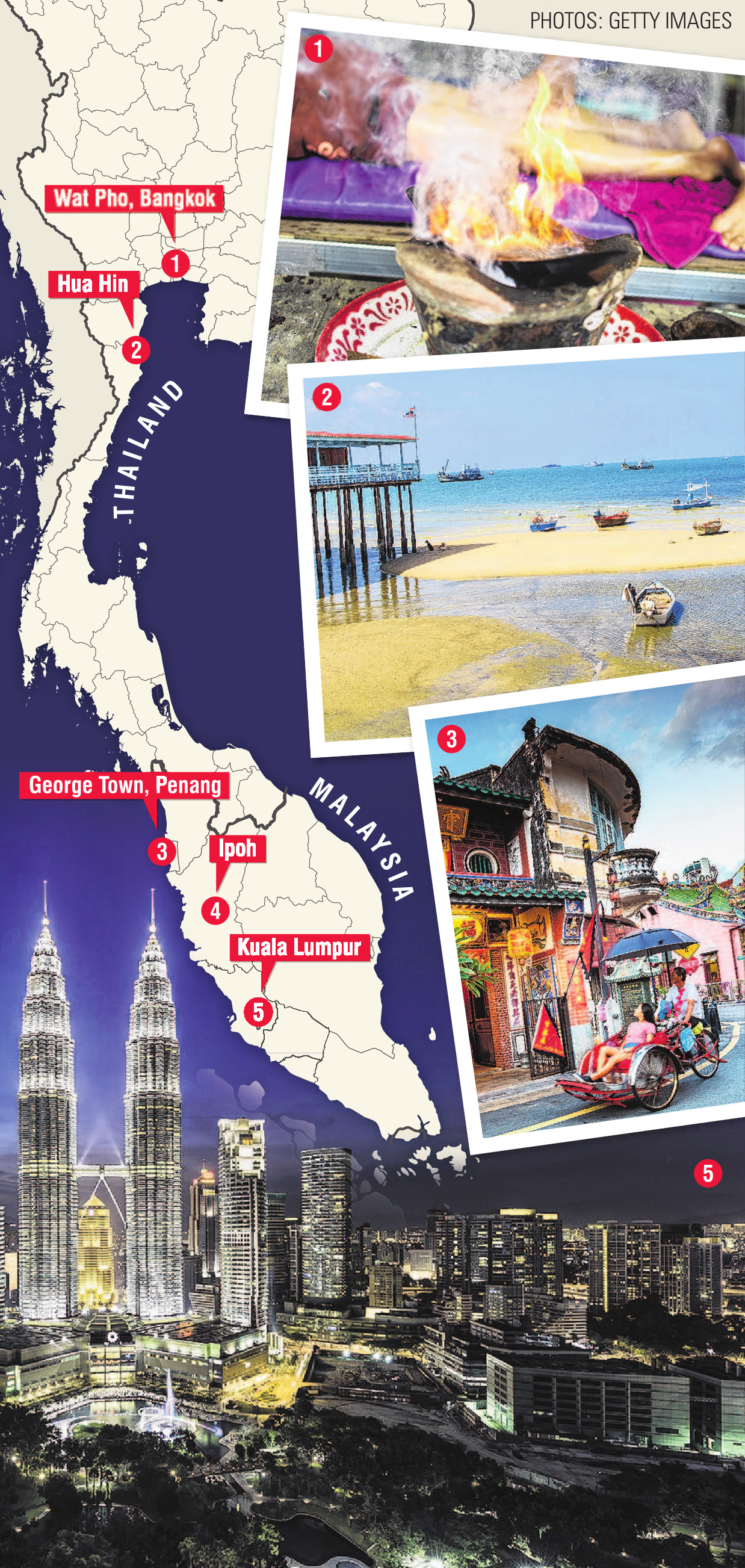
The Eastern & Oriental Express
Southeast Asia’s most luxurious train whisks passengers from Singapore to Bangkok in four lavish days, but you’ll need a Gordon Gekko-sized budget to board it. Fortunately, there is also a low-cost way to zip along the Malay Peninsula by rail, and it delivers a deep dive into the region’s rich cultural melting pot as part of the package.


The trip
Distance: 1900km. Mode of transport: Train. Difficulty: Moderate.
1 Wat Pho, Bangkok: Say goodbye to Bangkok with a relaxing rub-down at the spiritual home of Thai massage;
2 Hua Hin, Thailand: Pause the journey south for sea, sand and seafood in the country’s oldest resort;
3 George Town, Penang: An almost mandatory stop for fabulous Malaysian food, terrific temples and time-travel street scenes;
4 Ipoh Old Town: Gorge on history (and beansprout chicken) in this foodie former mining town in northwest Malaysia;
5 Kuala Lumpur: Globetrotting menus and skyscraping towers define Malaysia’s futuristic capital.
Let the journey be the destination

Know the peninsula through its people

Muse away the miles to the border

Follow your tastebuds through Malaysia
At Padang Besar, you’ll complete customs formalities and change over to the Malaysian rail network, starting with the Komuter train to Butterworth. Over the next few hours, there’ll be several chances to hop off the train and buzz over to the gorgeous, sand-circled island of Langkawi. Alternatively, save the island-hopping for Penang. Fast passenger ferries zip from Butterworth to George Town, where you can gorge on bowls of laksa (spicy noodle soup), penny-priced roti canai (buttery flatbread with spicy dipping sauces) and kari kapitan, Malaysia’s signature Indian-influenced curry. If you can tear yourself away from Penang’s treats and temples, more culinary education awaits two hours south in languid Ipoh, a former hub for tin miners and 18th-century gangsters, with a historic Old Town. Here, Chinese flavours dominate — head to the junction of Jalan Dato Tahwil Azar and Jalan Yau Tet Shin to sample the town’s best tauge ayam, steamed chicken and rice with seasoned beansprouts. Electrified ETS trains roll on to the historic train station in Malaysia’s capital, Kuala Lumpur, where you can chow down on claypot chicken in Chinatown, graze on Malay curries with a view of the skyscrapers in Kampung Baru, or take a tasting tour around the Indian subcontinent in Brickfields. By the end of your trip, your mental map of Malaysia will be marked with main courses rather than monuments. The final leg to Singapore is more complicated than it should be. First comes a seven-hour train ride to the border town of Johor Bahru, with an inconvenient change in Gemas. Then you can finally cross the causeway to Singapore — a convoluted process by train, but an easy hop by taxi or bus via the Woodlands Mass Rapid Transit station. Phew! After a journey of ample thinking time, cultural immersion and fabulous food, bookend the trip with a slap-up dinner at Michelin-starred Hill Street Tai Hwa Pork Noodle in Kallang, or feast on treats from across the peninsula in the teeming Chinatown Complex. If you didn’t know the Malay Peninsula before you started, you certainly do now.

Tastes of the peninsula
The Malay Peninsula is one of the world’s great culinary melting pots, but this festival of flavours didn’t come about overnight. Early traders from India, China and the Middle East brought in most of the spices used in Thai and Malay cooking, but the Portuguese provided the humble chilli, pushing every dish sharply up the Scoville scale. Before European colonialism, the peppercorn was king, imported from India along with the word curry, a corruption of the Tamil word kari, meaning spiced sauce. The British had a more circuitous impact. To serve the empire’s insatiable appetite for trade, labourers, tea-pickers and mine workers were brought in from India and southern China, adding new layers of complexity to the local cuisine and cementing teh tarik (pulled tea) as the national drink. Dining out on the peninsula today is a sampling menu of flavours from across Asia. Bring an appetite!
Practicalities
Region: Thailand/Malaysia/Singapore
Start: Bangkok, Thailand
Finish: Singapore
Getting there and back: Many airlines linking Europe and Australia fly to Bangkok and Singapore, so you can book an open-jaw ticket and cover the distance between these two megacities by rail. For a greener alternative, trains and buses connect Bangkok to cities across Southeast Asia; ferries fan out from Singapore to Indonesia’s islands.
When to go: The optimum time to travel varies, depending on where you plan to break the journey. For stops on the Andaman Coast, the driest months are from November to February. For destinations on the Gulf Coast, the dry months are from February to April.
What to take: As for any long-distance rail journey, youll benefit from a travel pillow, ear plugs and, for instant privacy, a music player with earphones.
Where to stay: If you’re riding straight through from Bangkok to Padang Besar, consider a sleeper berth (you’ll get less cultural immersion but more comfort). Otherwise, ride the rails by day and sleep in hostels, beach cabins or hotels wherever you stop for the night. Bookings are recommended during the busier dry months.

Where to eat and drink: Thai and Malaysian trains have dining cars for sleeper-class passengers; in third class, hawkers wander the carriages and station platforms selling portable meals such as fried chicken with sticky rice.
Essential things to know: Book train tickets through 12GoAsia (12go.asia), State Railway of Thailand (dticket.railway.co.th) or Malaysian operator KTM (ktmb.com.my). Reserve ahead for sleepers; for short third-class trips, buy tickets at the station on the day. Keep your passport handy for border checks at Padang Besar and on the Singapore causeway.
The book
Your Trip Starts Here by Lonely Planet, RRP $44.99.












